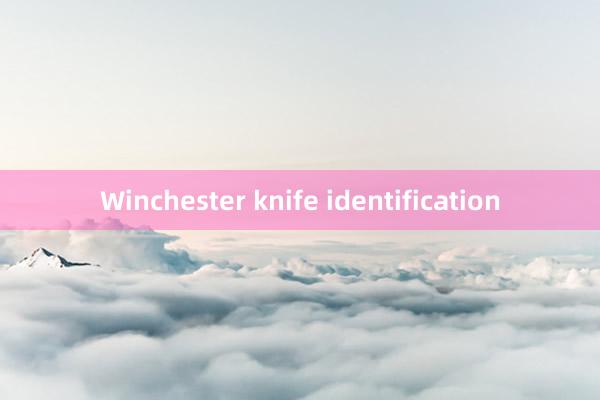Winchester knife identification

Winchester Knife Identification: A Guide for Collectors
Winchester knives are renowned for their quality craftsmanship and history, making them popular among collectors and outdoor enthusiasts. Identifying a Winchester knife can help determine its age, value, and authenticity. This guide will walk you through the key aspects of Winchester knife identification, from understanding the brand's history to recognizing distinctive features.
A Brief History of Winchester Knives
Winchester Repeating Arms Company, established in the mid-19th century, is best known for its firearms. However, the company ventured into the knife-making industry in the early 20th century. In 1919, Winchester began producing knives to diversify its product line and leverage its reputation for high-quality metalwork. The original Winchester knives were manufactured in the United States and became highly regarded for their craftsmanship and durability.
Production of Winchester knives ceased during the Great Depression due to financial difficulties, but the brand's knife legacy did not end there. Since then, there have been several attempts to revive the Winchester knife line. In the modern era, Winchester-branded knives are typically produced under licensing agreements with companies such as Bluegrass Cutlery and Bear & Son Cutlery. While these knives still carry the Winchester name, their origins and quality may differ from the early 20th-century originals.
Understanding Winchester Knife Markings
The markings on a Winchester knife can reveal a lot about its origins. These markings include the tang stamp, model number, and additional inscriptions. Knowing how to interpret these can aid in identifying the knife's age and authenticity.
-
Tang Stamp: The tang stamp is one of the most significant indicators of a Winchester knife’s production date. Original Winchester knives made between 1919 and the early 1940s will have a tang stamp that reads "Winchester Trade Mark" along with "Made in U.S.A." Modern reproductions might feature different tang stamps, such as "Winchester" followed by "Trademark License," indicating a licensed production run. It's important to note that variations in the tang stamp could be due to different manufacturing eras or companies authorized to produce Winchester knives.
-
Model Number: Another identifier on a Winchester knife is the model number. This number can typically be found alongside the tang stamp or elsewhere on the knife's blade. Older models may have three-digit numbers, while modern Winchester knives often feature a longer set of characters or numbers. Cross-referencing the model number with a Winchester knife collector’s guide can help identify the period during which the knife was made and the specific style or type of knife.
-
Additional Inscriptions and Symbols: Apart from the tang stamp and model number, some Winchester knives may also have special etchings or symbols on the blade or handle, indicating a limited edition, commemorative run, or a custom collaboration. For instance, some knives may have special inscriptions celebrating historical events or anniversaries of the Winchester brand.
Differentiating Between Original and Modern Winchester Knives
Distinguishing between original early 20th-century Winchester knives and modern reproductions is crucial for collectors. Several factors can help determine whether a knife is vintage or contemporary.
-
Blade Material and Construction: Vintage Winchester knives are often made from high-carbon steel, which may show signs of patina due to age. Modern Winchester knives tend to use stainless steel, which does not develop the same kind of patina. Additionally, the construction methods and materials used in the handle can provide clues about the knife's era. For example, early models might have bone, wood, or stag handles, while more recent knives may feature synthetic materials.
play go88Sunwin đổi thưởng -
Packaging and Certificates of Authenticity: Older Winchester knives might not come with the original packaging, but if they do, it is typically a wooden or cardboard box. Modern reproductions, on the other hand, often come with detailed packaging and certificates of authenticity. These certificates usually contain information about the knife’s production date and materials used. The absence of such documentation does not always mean a knife is not authentic, but it does make identification more challenging.
-
Price and Condition: As with most collectibles, the price of a Winchester knife can be an indicator of its authenticity and age. Vintage models in good condition tend to command higher prices than modern reproductions. Checking the knife’s condition—such as signs of wear, blade sharpening, and handle aging—can also provide hints about its age. However, some modern reproductions are made to look "aged" to give them a vintage appearance, so it is vital to verify other factors before making a conclusion.
Resources for Winchester Knife Collectors
For collectors seeking more information on Winchester knife identification, several resources are available:
-
Collector's Guides and Books: Numerous books are dedicated to Winchester knives and other collectible blades. These guides often provide detailed information about specific models, production years, and distinguishing features. Reference materials like "The Standard Knife Collector's Guide" include photographs and descriptions that can aid in accurate identification.
-
Knife Collecting Forums and Online Communities: Engaging with knife collecting forums or online communities, such as BladeForums or Knife Magazine, can be beneficial. Experienced collectors often share tips, photos, and advice on identifying specific Winchester knives. Posting pictures of your knife in these communities may also help others give you insights.
-
Knife Shows and Collectors' Associations: Attending knife shows or joining collectors' associations can provide opportunities to see a wide variety of knives and meet other enthusiasts. These events often feature expert appraisers who can help identify and authenticate Winchester knives.
Conclusion
Winchester knives hold a special place in the history of American knife-making. Understanding how to identify them, from examining tang stamps and model numbers to evaluating the materials used, is essential for collectors who want to ensure they are acquiring authentic pieces. While distinguishing between vintage and modern Winchester knives can be challenging, a keen eye and the right resources can make the task easier and more rewarding. For anyone interested in these iconic blades, the journey of identification is as fulfilling as the knives themselves.
JILI22 promotionwww.seo8.net

